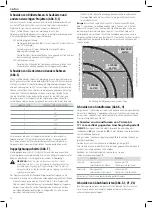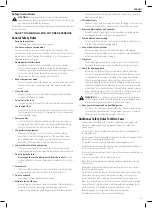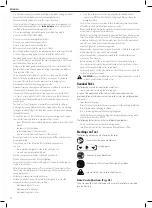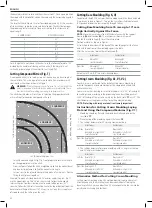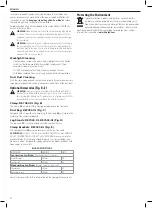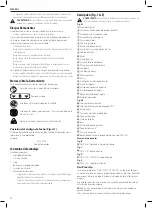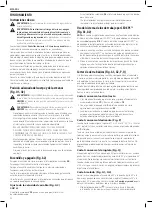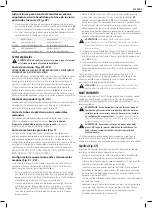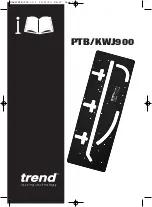
41
EnGLISh
Instructions for Cutting Crown Moulding Angled
Between the Fence and Base of the Saw for All
Cuts (Fig. V2)
1. Angle the moulding so the bottom of the moulding (the part which
goes against the wall when installed) is against the fence
14
and the
top of the moulding is resting on the saw table
17
.
2. The angled “flats” on the back of the moulding must rest squarely on
the fence and saw table.
Inside Corner
Outside Corner
Left side
Mitre right at 45°
Save right side of cut
Mitre left at 45°
Save right side of cut
Right side
Mitre left at 45°
Save left side of cut
Mitre right at 45°
Save left side of cut
Special Cuts
WARNING:
Never make any cut unless the material is secured
on the table and against the fence.
Aluminum Cutting (Fig. W1, W2)
ALWAYS USE THE APPROPRIATE SAW BLADE MADE ESPECIALLY FOR
CUTTING ALUMINUM.
Certain workpieces may require the use of a clamp or fixture to prevent
movement during the cut. Position the material so that you will be cutting
the thinnest cross section, as shown in Figure W1. Figure W2 illustrates the
wrong way to cut these extrusions.
Use a stick wax cutting lubricant when cutting aluminum. Apply the stick
wax directly to the saw blade
42
before cutting. Never apply stick wax to
a moving blade. The wax provides proper lubrication and keeps chips from
adhering to the blade.
Bowed Material (Fig. X1, X2)
When cutting bowed material always position it as shown in Figure X1 and
never like that shown in Figure X2. Positioning the material incorrectly will
cause it to pinch the blade.
Cutting Plastic Pipe or Other Round Material
Plastic pipe can be easily cut with your saw. It should be cut just like
wood and
CLAMPED OR HELD FIRMLY TO THE FENCE TO KEEP IT FROM
ROLLING
.
This is extremely important when making angle cuts.
Cutting Large Material (Fig. Y)
Occasionally you will encounter a piece of wood a little too large to fit
beneath the lower guard. If this occurs, place your right thumb on the
upper side of the guard
1
and roll the guard up just enough to clear the
workpiece, as shown in Figure Y. Avoid doing this as much as possible, but
if need be, the saw will operate properly and make the bigger cut. NEVER
TIE, TAPE, OR OTHERWISE HOLD THE GUARD OPEN WHEN OPERATING
THIS SAW.
Special Set-up for Wide Crosscuts (Fig. Z1, Z2)
Your saw can cut very wide (up to 409 mm) workpieces when a special set-
up is used. To set the saw up for these workpieces, follow these steps:
1. Remove both left and right sliding fences from the saw and set aside. To
remove them, unscrew the fence adjustment knobs
13
several turns
and slide each fence outward. Adjust and lock the mitre control so that
it is at 0° mitre.
2. Make a platform using a piece of 38 mm thick particleboard or similar
flat strong 38 mm thick wood to the dimensions: 368 x 660 mm. The
platform must be flat, otherwise the material could move during cutting
and cause injury.
3. Mount the 368 x 660 mm platform to the saw using four 76.2 mm long
wood screws through the holes
57
in the base fence
15
(Fig. Z1).
Four screws must be used to properly secure the material. When the
special set-up is used, the platform will be cut into two pieces. Ensure
the screws are tightened properly, otherwise material could loosen and
cause injury. Ensure the platform is firmly flat on the table, against the
fence, and centred evenly from left to right.
WARNING:
Ensure the saw is mounted firmly to a stable flat surface.
Failure to do so could cause the saw to be unstable and fall causing
personal injury.
4. Place the workpiece to be cut on top of the platform mounted to the
table. Ensure the workpiece is firmly against the back of the base fence
15
(Fig. Z2).
5. Secure the material before cutting. Cut slowly through the material
using a out-down-and-back motion. Failure to clamp securely or cut
slowly could result in the material coming loose and causing injury.
After several cuts are made at various mitre angles other than 0°, the
platform may weaken and not properly support the work. Install a new,
unused platform to the saw after presetting the desired mitre angle.
CAUTION:
Continued use of a platform with several kerfs may cause
loss of material control and possible injury.
MAINTENANCE
Your
D
e
WALT
power tool has been designed to operate over a long period
of time with a minimum of maintenance. Continuous satisfactory operation
depends upon proper tool care and regular cleaning.
WARNING: To reduce the risk of injury, turn unit off and
disconnect machine from power source before installing and
removing accessories, before adjusting or changing set-ups
or when making repairs.
Be sure the trigger switch is in the OFF
position. An accidental start-up can cause injury.
WARNING: To reduce the risk of serious personal injury, DO NOT
touch the sharp points on the blade with fingers or hands while
performing any maintenance.
DO NOT use lubricants or cleaners (particularly spray or aerosol) in the
vicinity of the plastic guard. The polycarbonate material used in the guard is
subject to attack by certain chemicals.
Brushes (Fig. A1)
Inspect carbon brushes regularly. Keep brushes clean and sliding freely in
their guides.
• Unplug tool, remove the motor end cap
6
, lift the brush spring and
withdraw the brush assembly.
• If the brushes are worn down to approximately 12.7 mm, the springs
will no longer exert pressure and they must be replaced.
• Use only identical DeWalt brushes. Use of the correct grade of brush is
essential for proper operation of electric brake. New brush assemblies
are available at
D
e
WALT
service centres.
• Always replace the brush inspection cap after inspection or servicing
the brushes.
• The tool should be allowed to “run in” (run at no load) for 10 minutes
before use to seat new brushes. The electric brake may be erratic in
operation until the brushes are properly seated (worn in).
• While “running in” DO NOT TIE, TAPE, OR OTHER WISE LOCK THE
TRIGGER SWITCH ON. HOLD BY HAND ONLY.
Lubrication
Your power tool requires no additional lubrication.
Cleaning
Before use, carefully check the upper guard, lower guard and dust duct
to determine that they will operate properly. Ensure that chips, dust or
workpiece particles do not block of one of the functions.
Summary of Contents for DWS779
Page 1: ...Final Page Size 172 x 240 mm DWS779 DWS780 ...
Page 4: ...2 Fig D Fig C Fig B Fig E Fig G1 Fig F 2 1 35 37 36 38 ...
Page 6: ...4 Fig N Fig O1 Fig O2 Fig L Fig M Fig K 73 mm 21 21 55 56 58 59 7 ...
Page 7: ...5 Fig Q Fig S Fig P Fig T Fig U 2 Fig R 1 A ...
Page 8: ...6 Fig X1 ss Fig X2 Fig W1 Fig W2 Fig V2 Fig V1 42 14 14 42 14 17 17 14 ...
Page 9: ...7 Fig Y Fig Z1 Fig Z2 15 1 15 13 57 ...
Page 162: ......
Page 163: ......


